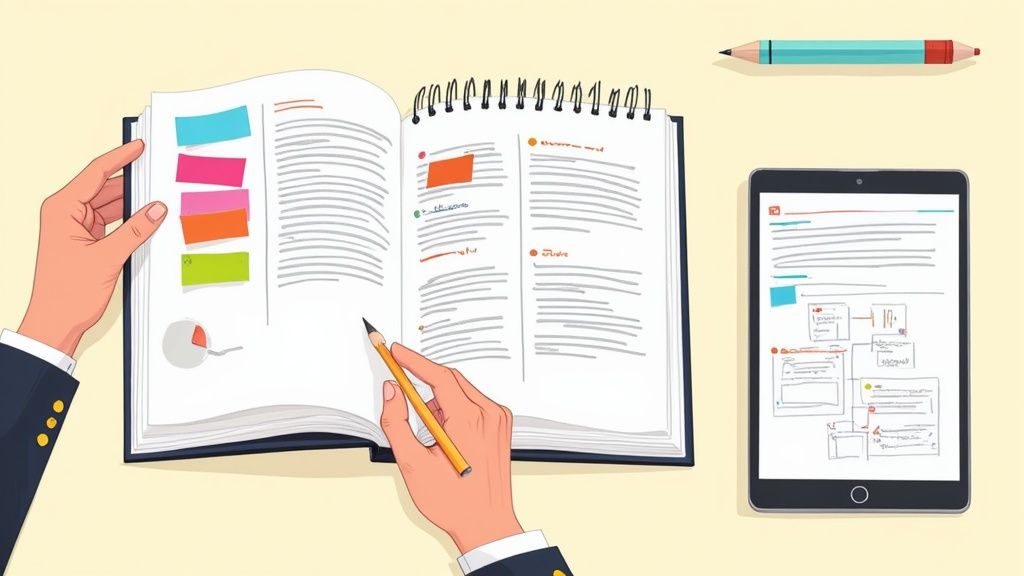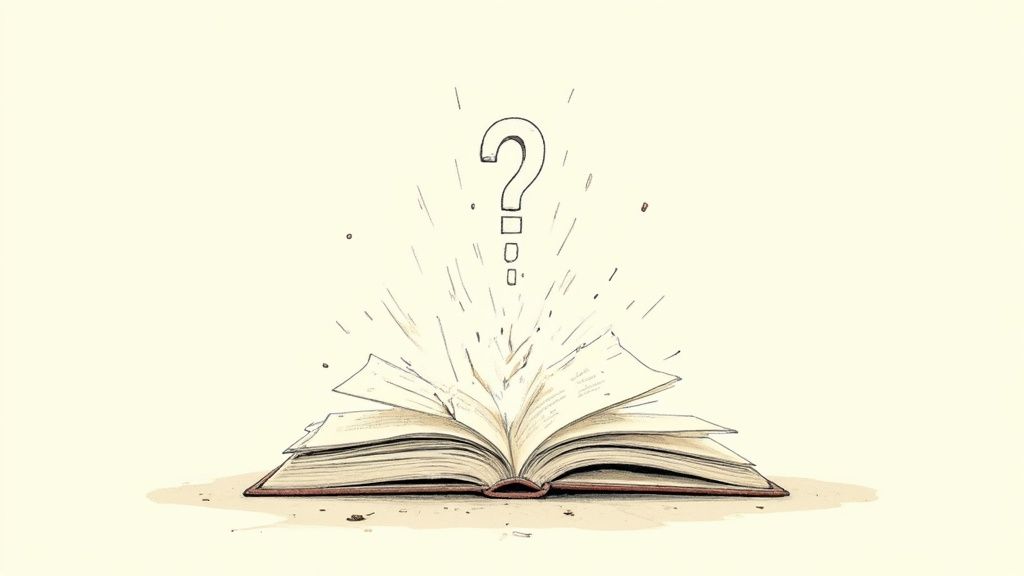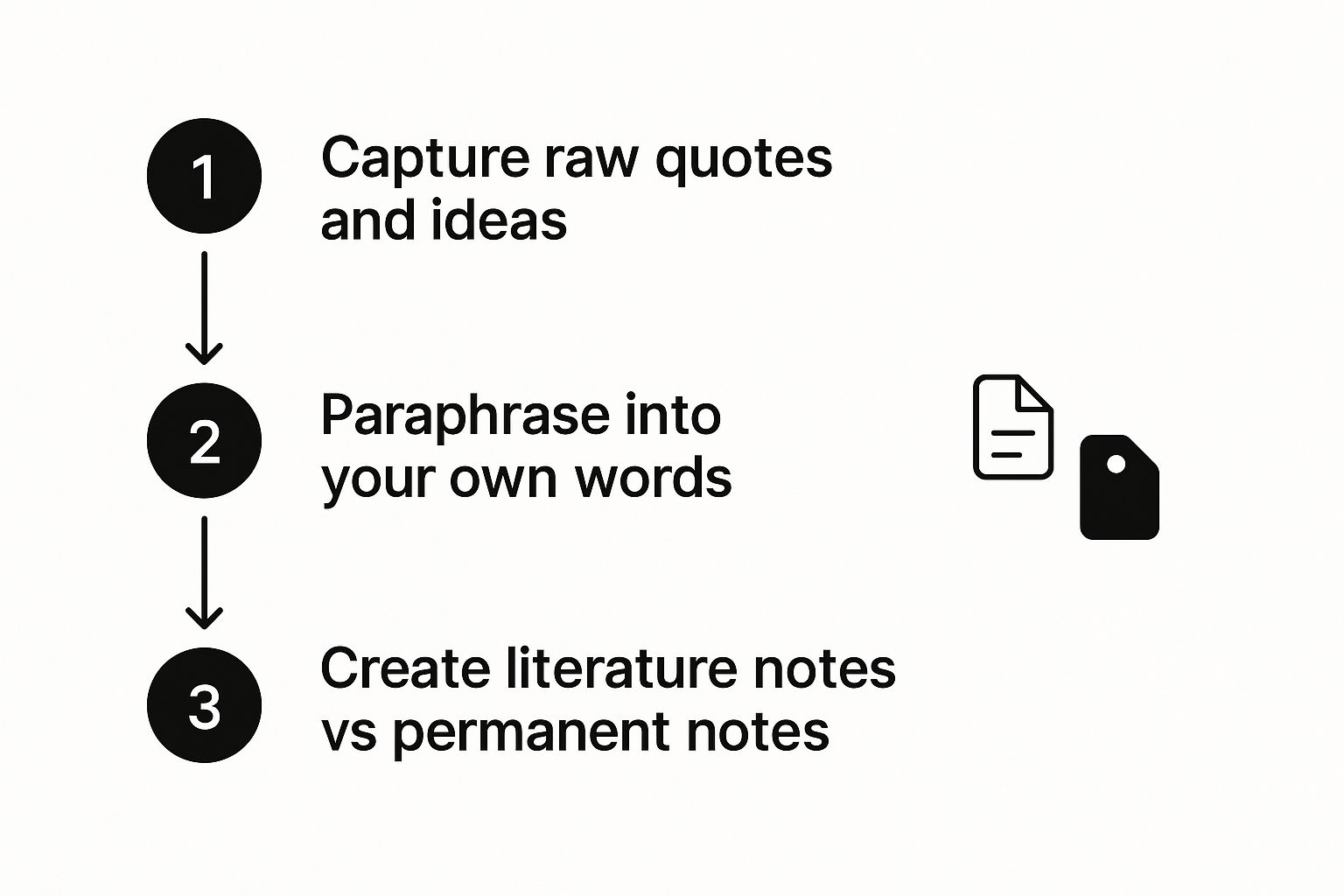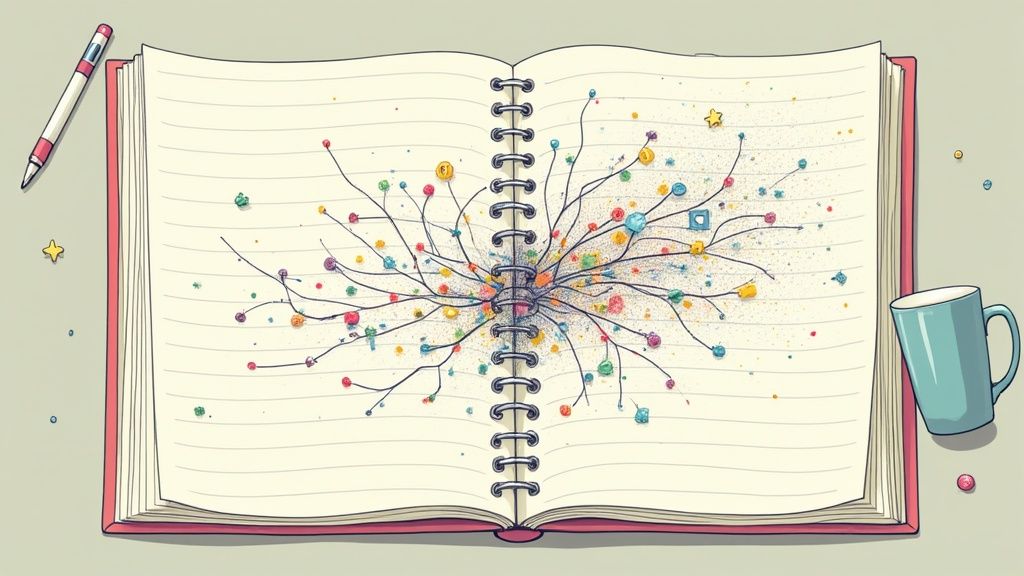Master Effective Taking Notes on a Book Strategies

Taking notes on a book should feel less like transcribing and more like having an active dialogue with the author. The real goal is to move beyond just highlighting passages that seem important. It's about building a lasting, interconnected web of knowledge you can actually tap into long after you've closed the cover.
When done right, your notes ensure those brilliant insights don't just vanish.
Why Your Book Highlights Are Not Working

Let's be honest. How many of those brightly colored highlights or cryptic margin notes have you ever actually gone back to? If you're like most of us, that book full of yellow lines is just sitting on a shelf, its wisdom trapped between the pages.
This is the classic pitfall of passive note-taking. It feels productive in the moment, but it rarely leads to genuine understanding or retention.
Simply dragging a highlighter across a sentence doesn't force your brain to process its meaning. It’s a cognitive shortcut. You’re essentially telling your future self, "Hey, this is important," without engaging with why it's important right now. This is why the method fails—it doesn't forge the mental connections needed to cement information into your long-term memory.
The Illusion of Comprehension
Passive methods are sneaky. They create an illusion of comprehension. You recognize the words, you nod along with the idea, but you haven't truly wrestled with it, challenged it, or tried to rephrase it in your own words.
This is exactly why you can finish a fantastic book and struggle to recall its main arguments just a week later. Your "notes" are just a collection of isolated fragments, not the building blocks of real knowledge.
This isn't just a hunch; it's rooted in how our brains learn. Research consistently shows that the act of processing and reviewing material is what strengthens recall, turning fleeting information into usable knowledge.
True learning from a book doesn't come from capturing the author's words perfectly. It comes from translating those words into your own thoughts, creating a bridge between their ideas and your existing knowledge.
Before we dive into a better approach, let's clarify the difference between passive and active methods.
Passive vs Active Note-Taking on Books
Most of us start with passive methods because they're easy, but the payoff is minimal. Active note-taking requires more effort upfront but delivers lasting value. Here's a quick breakdown of how they compare:
Primary Action
Highlighting, underlining, copying quotes verbatim.
Paraphrasing, summarizing, asking questions, connecting ideas.
Cognitive Effort
Low. Focuses on recognition.
High. Requires synthesis and critical thinking.
Outcome
A collection of isolated quotes and phrases.
An interconnected web of personal insights and knowledge.
Retention
Poor. Information is quickly forgotten.
Strong. Creates lasting mental connections.
Reusability
Low. Highlights are hard to search or connect.
High. Notes become building blocks for future projects.
Seeing them side-by-side makes the choice pretty clear. If the goal is genuine learning, we have to move beyond the highlighter.
From Passive Highlighting to Active Engagement
The alternative is a deliberate, active approach where every note you take serves a purpose. This is about shifting your mindset from merely collecting quotes to synthesizing ideas. When you actively process what you read, your notes become a dynamic extension of your thinking process.
For instance, instead of just highlighting a powerful quote, you might:
Paraphrase the idea: How would you explain this concept to a friend? Write that down in a separate note.
Ask questions: What does this imply? How does this contradict something I read in another chapter? What am I skeptical about here?
Connect to other knowledge: Link this idea to something you learned from another book, an article, or a personal experience.
This is where a system like Obsibrain truly shines. For example, a student researching a history paper can use Obsibrain to capture key arguments from different books, ask critical questions about each source, and link them to a central "Thesis" note. This turns reading into an active research process. The real magic happens over time.
Instead of a graveyard of forgotten highlights, you build a living, breathing library of interconnected ideas. You can then use features like Obsibrain's periodic reviews to resurface these insights automatically, ensuring they stay fresh in your mind and contribute to your long-term growth.
Define Your Reading Mission Before You Start

Here’s a hard truth: effective note-taking doesn't start on page one. It begins before you even open the book, with one simple but powerful question: "Why am I reading this?"
If you don’t have a clear answer, you’re just wandering. You'll end up highlighting passages that feel interesting in the moment but have no real direction. You’re collecting trivia, not building knowledge.
Defining your purpose turns passive reading into an active hunt for treasure. Your goal becomes a powerful filter, helping you instantly spot what’s relevant and ignore the fluff. Honestly, this single act of setting an intention is the biggest leap you can take toward creating book notes you'll actually use.
Crafting Your Guiding Questions
Once you’ve got your "why," the next move is to shape it into a few sharp, guiding questions. Think of these as your intellectual toolkit, focusing your attention on the specific gems you need to unearth. You’re not just reading; you’re having a direct conversation with the author, seeking answers.
Let's say you're diving into a book on habit formation because you want to finally nail down a morning routine. Your questions might look something like this:
What are the three most actionable strategies I can implement next week?
How does the author’s framework tackle procrastination head-on?
What mental models can I borrow for sticking with habits when my motivation tanks?
See the difference? You're no longer just a reader—you're a detective on a mission. Every chapter is a lead, and every note you jot down is a clue that directly answers a question you've already decided is important.
The Role of Your System
This is where a tool like Obsibrain really shines. Before you read a single word, pop open your Obsidian vault and create a new note for the book. Right at the very top, list your guiding questions. This simple prep work keeps your mission front and center.
Setting a clear purpose before reading is the ultimate time-saver. It ensures every note you capture is not just interesting, but directly applicable to your goals, turning passive consumption into active problem-solving.
As you start reading and pulling out ideas, you can link them directly back to the specific questions they answer. This pre-reading ritual is a total game-changer. For example, a manager reading a book on leadership could create a note in Obsibrain with questions like "How can I improve team meetings?" and "What are better feedback techniques?" Now, every time they capture an insight, they’re not just saving it—they're connecting it to a specific, actionable professional goal.
Find the Right Note-Taking System for You
Just like there's no single perfect book, there’s no universally perfect way to take notes on one. The best system is always the one that clicks with how your brain works and serves the mission you’ve already set for your reading.
Don't try to force a method that feels unnatural. Instead, think of different systems as tools in a toolbox. Your job is to pick the right one for the task at hand, whether you’re dissecting a dense academic text or just trying to capture sparks of creative insight.
The Zettelkasten Method for Connecting Ideas
The Zettelkasten method, which is German for "slip-box," is less of a note-taking technique and more of a whole system for thinking. The core idea is brilliantly simple: each note you create contains a single, atomic idea, written entirely in your own words. These individual notes are then linked to other related notes, creating a growing web of interconnected knowledge.
This approach is a game-changer for non-fiction readers who want to build a deep, compounding understanding of a topic over time. Instead of having your notes locked away in silos for each book, you build a living network of insights that connect ideas across everything you read.
For instance, a note on "cognitive biases" from Thinking, Fast and Slow could link to another note on "marketing psychology" from a business book, and even to a note on "character flaws" from a novel you read last year.
The real power of Zettelkasten isn’t just capturing ideas; it's in the connections you forge between them. Each link you create is a new thought, a fresh insight that didn't exist before.
With Obsibrain, this method feels completely seamless. A writer, for example, can create atomic notes on plot structure from one book and character development from another. Obsibrain’s linking features allow them to connect these disparate ideas, generating novel concepts for their own stories. The graph view in Obsidian then visually maps these connections, helping you spot unexpected patterns and generate new ideas just by seeing how different concepts intersect.
The Cornell Method for Structured Summaries
Developed at Cornell University, this method is perfect if you need a structured, organized overview of a book's content. It works by dividing your page into three distinct sections: a main note-taking column, a smaller cue column, and a summary section at the very bottom.
Main Notes Column: This is your primary space. As you read, you'll jot down key concepts, important quotes, and any data that stands out.
Cue Column: After you've finished a section, you review your main notes and pull out keywords or questions, placing them here. This step forces you to distill the most critical points.
Summary Section: Lastly, you write a quick one or two-sentence summary of that page's content. This really helps cement your understanding.
This system is fantastic for studying or anytime you need to quickly recall the core arguments of a book. It’s a disciplined approach that builds comprehension through active review and synthesis.
Mind Mapping for Visual Thinkers
If you tend to think in pictures and connections rather than linear lists, mind mapping might be your go-to system. This technique starts with the book's central idea right in the middle of the page. From there, main themes branch out like tree limbs, with sub-topics, specific examples, and quotes branching off from those.
Mind mapping is excellent for grasping the overall structure of a book and seeing how all the different parts relate to the whole. It's a much more creative and free-flowing way of taking notes on a book, making it perfect for brainstorming or exploring complex, non-linear topics. If you're looking for digital tools to help with this, you might want to check out recommendations for the best reference manager for annotations and note-taking.
This approach is only getting more powerful with new digital tools. The global AI note-taking market was valued at $450.7 million in 2023 and is projected to skyrocket to $2.545 billion by 2033, showing a huge demand for smarter ways to manage information. Your choice of system will ultimately depend on your personal style and the kind of book you're diving into.
How to Capture and Process Your Notes
You've figured out your reading mission and picked a system that feels right. Great. Now for the most important part: the actual mechanics of capturing insights from a book and, crucially, making them stick. This is where you turn raw highlights into real, usable knowledge.
It really boils down to two distinct phases. First, you have the capture phase, which needs to be as fast and smooth as possible. Then comes the processing phase—a more deliberate moment where you wrestle with the ideas and make them your own.
This simple workflow shows how you can move from just passively collecting information to actively creating with it.

Think of this as the bridge between grabbing an author's words and generating your own unique thoughts.
Master the Art of Quick Capture
The name of the game during the capture phase is speed. You want to grab quotes, thoughts, and questions without derailing your reading flow. Nothing kills momentum faster than constantly switching between your book and a clunky app.
Your method has to be simple. Whether it's a trusty notebook, a handful of sticky notes, or a digital tool, it must be ready to go in an instant. This is an area where a tool like Obsibrain really shines. You can use its built-in features to get an idea down without breaking your concentration. For the nitty-gritty on how to get that going, you can learn more about Obsibrain's quick capture and notes system.
Let’s walk through a real-world example. Say you're reading and come across this gem: "Habits are the compound interest of self-improvement."
Instead of just highlighting it and moving on, you quickly jot this down:
Quote: "Habits are the compound interest of self-improvement." – James Clear
My thought: This totally connects to the concept of small, consistent financial investments. Tiny daily actions feel like nothing, but they build massive results over time.
This raw note is just your starting point. You haven't really processed it yet; you've just snagged the stimulus and your immediate reaction to it.
Process Your Notes by Paraphrasing
The real magic happens when you start processing. This is where you revisit your raw captures and put them into your own words. Look, simply copying a quote doesn't prove you understand it. Paraphrasing forces your brain to actually grapple with the concept, which is what cements it in your memory.
Take that raw note from earlier and let's actively process it. This means creating two different kinds of notes.
The most valuable notes aren't the ones you take, but the ones you make. Processing is how you turn an author's ideas into your own intellectual property.
First up, you create a literature note. This is just a short summary of the author's main idea, but in your own words. It's all about what they were saying.
Literature Note Example: James Clear argues that habits function a lot like compounding interest. Just as small, consistent deposits into a savings account grow into a large sum, small daily habits accumulate to produce significant, long-term personal growth.
With that done, you now create a permanent note. This is your unique insight, your question, or a connection sparked by the original idea. This is all about what you think.
Permanent Note Example: The "compound interest" model for habits shines a light on a major flaw in short-term goal setting. We often give up because the early results are invisible, just like a tiny investment shows almost no growth at first. The trick is trusting the long-term compounding process, even when it feels like nothing is happening.
Inside a tool like Obsibrain, this is where things get really powerful. A project manager could tag this permanent note with #productivity and #team-motivation. Later, when preparing for a team workshop, Obsibrain’s AI can surface this note as a relevant concept, even if it came from a book on personal finance, demonstrating the power of cross-contextual insights.
Turn Your Notes Into a Network of Knowledge

Isolated notes are a bit like unread books on a shelf—they have potential, but not much real value. Their power is unlocked when they start talking to each other. The whole point of taking notes on a book is to eventually build an interconnected network where a new idea from your current read can instantly link up with concepts from other books, articles, or even your own life experiences.
This is where you make the shift from just being a collector of information to a creator of insights. Each new note doesn't just get added to a pile; it strengthens the entire web, making every piece of knowledge you've captured that much more valuable.
Forging Connections Between Your Ideas
The trick is to actively look for links. As you process a new note, always ask yourself, "What does this remind me of?" It might be a concept about decision-making from a business book that connects perfectly to a character's dilemma in a novel you read last year.
In a physical notebook, you might use an index or special symbols to cross-reference pages. But when you go digital, this process becomes exponentially more powerful. Tools like Obsibrain are built on this very principle. Using backlinks, you can create a direct, clickable link between a note on "habit formation" and another on "productivity systems."
The magic of a knowledge network is its ability to generate unexpected insights. You start to see patterns and connections that were previously invisible, turning your collection of notes into an engine for new ideas.
Over time, this practice builds a personal web of knowledge that is uniquely yours. It’s a custom-built thinking environment where every idea supports and enriches the others.
Visualize and Query Your Knowledge
This is where modern note-taking really leaves traditional methods in the dust. With a tool designed for networked thought, you can see your knowledge in entirely new ways.
Graph View: Features like the graph view in Obsidian visually map out your entire network. This shows you clusters of thought and often reveals surprising connections between topics you wouldn't have otherwise linked.
AI-Powered Queries: Imagine being able to ask your notes, "How does this idea on cognitive biases connect to the marketing strategies I read about last month?" With Obsibrain, a consultant can query their entire knowledge base to find intersections between client feedback, industry reports, and leadership books, generating unique solutions for their next project.
This dynamic interaction transforms your notes from a static archive into an active thinking partner. The global market for digital note-taking is expanding rapidly for a reason, with North America leading the charge as more people adopt these advanced tools.
Of course, a structured approach needs a clear organizational system. To get started, you might find it helpful to explore the P.A.R.A. folder structure over at our guide, which can bring some much-needed order to your digital projects and resources: https://docs.obsibrain.com/features/p.a.r.a-folder-structure
Ultimately, the goal is to make sure the time you spend reading and note-taking pays dividends for years to come. The true measure of success is how well you can recall and apply what you've learned. For some great strategies on this, check out this guide on how to retain information better.
Common Questions About Taking Notes on a Book
Building any new habit feels a bit clumsy at first, and note-taking is no exception. It's totally normal to hit a few snags as you move from just highlighting passages to a more active, thoughtful process.
Let's walk through some of the most common hurdles I see people face. I'll give you some clear, practical advice to help you smooth out your workflow and stay consistent.
Digital Versus Analog Notes
One of the first big questions that pops up is whether to go digital or stick with analog. Honestly, there's no single "right" answer here. The best tool is always the one you'll actually use day in and day out.
But it helps to know the trade-offs.
Analog (Pen and Paper): There's something about the physical act of writing that really helps ideas stick. It's completely distraction-free and forces you to be selective about what you write down, which can lead to better summaries.
Digital (Apps like Obsidian): This is where things get powerful. Digital notes are searchable, can be linked together, and are easy to back up. A tool built for networked thought lets you connect ideas across hundreds of books in a way that’s just impossible with paper.
Lots of people land on a hybrid approach that works wonders. You might jot down quick thoughts in a small notebook while you're reading, then later, you process and expand on them in your digital system. This gives you the best of both worlds—the tactile benefit of writing and the long-term organizational muscle of a digital tool.
Finding Time to Process Your Notes
This is probably the biggest sticking point for most people. You’ve captured a ton of great quotes and ideas, but now they're just sitting in a digital pile, unprocessed. If you don't make time to review and synthesize them, you're only doing half the work.
The real goal isn't just to capture notes; it's to integrate them. Carving out just 15-20 minutes after a reading session to process what you've learned is far more effective than trying to do a massive review session once a month.
Seriously, block this time out on your calendar like it's a real appointment. Treat it as a non-negotiable part of the reading process itself, not some optional extra.
Overcoming Perfectionism
I see this all the time. People get completely stuck trying to craft the "perfect" note. They agonize over the exact phrasing, the structure, or whether an idea is "important" enough to even bother writing down. This kind of perfectionism will kill your momentum faster than anything else.
Your notes don't need to be beautiful, eloquent, or profound. Their main job is to help you think.
So give yourself permission to be messy. Capture half-formed thoughts, ask silly questions in your notes, and write clumsy summaries. You can always clean them up later. The most important thing is simply getting the idea out of your head and onto the page.
Inside Obsibrain, for instance, the "Quick Capture" feature is perfect for this. A researcher reading a dense academic paper can use it to instantly save a fleeting thought or question without losing their place. Later, during their scheduled processing time, they can flesh out that raw idea and link it to the right study, project, or concept. This little workflow trick separates capturing from organizing, which is a fantastic way to bypass that perfectionist paralysis.
Ready to build a powerful, interconnected knowledge system that actually grows with you? Obsibrain provides the structure and tools you need to turn your book notes into a dynamic library of insights. Stop losing valuable ideas and start building your second brain today. Learn more about Obsibrain and get started.
Last updated
Was this helpful?